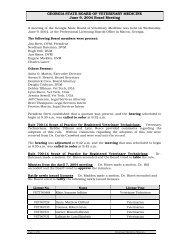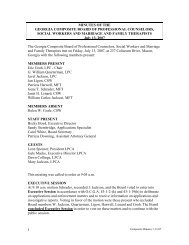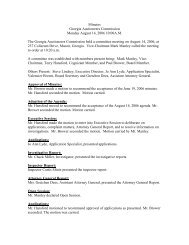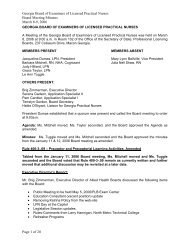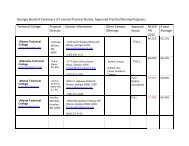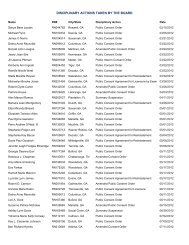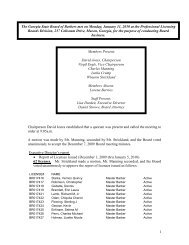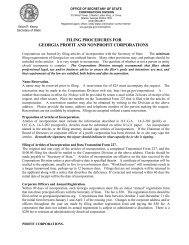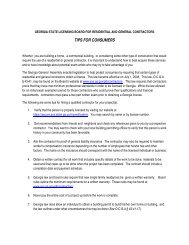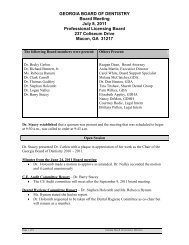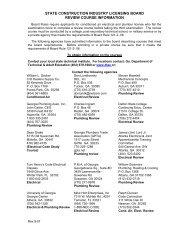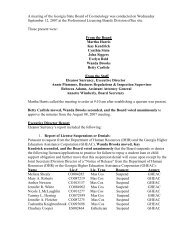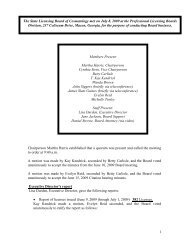Please visit www.nictesting.org for the most current bulletin
Please visit www.nictesting.org for the most current bulletin
Please visit www.nictesting.org for the most current bulletin
You also want an ePaper? Increase the reach of your titles
YUMPU automatically turns print PDFs into web optimized ePapers that Google loves.
NATIONAL HAIR DESIGN<br />
WRITTEN EXAMINATION<br />
CANDIDATE INFORMATION BULLETIN<br />
<strong>Please</strong> <strong>visit</strong> <strong>www</strong>.<strong>nictesting</strong>.<strong>org</strong> <strong>for</strong> <strong>the</strong> <strong>most</strong> <strong>current</strong> <strong>bulletin</strong> prior to testing.<br />
The National Hair Design examination is <strong>the</strong> national licensure examination <strong>for</strong> Hair Designers, which is developed and administered by <strong>the</strong> National-<br />
Interstate Council of State Boards of Cosmetology (NIC). This Candidate In<strong>for</strong>mation Bulletin includes <strong>the</strong> content outline covered by <strong>the</strong> NIC National<br />
Hair Design examination, sample questions and answers. The time allowed <strong>for</strong> <strong>the</strong> Hair Design written examination is 90 minutes.<br />
SCIENTIFIC<br />
CONCEPTS<br />
40%<br />
Infection Control<br />
Microbiology<br />
Bacteria<br />
Viruses<br />
Parasites<br />
Immunity<br />
Prevention<br />
Methods of infection control<br />
Sanitation<br />
Disinfection<br />
Sterilization<br />
Federal regulations<br />
OSHA guidelines<br />
Material Safety Data<br />
Sheets (MSDS)<br />
Environmental Protection<br />
Agency (EPA)<br />
Food and Drug<br />
Administration (FDA)<br />
Universal precautions<br />
First Aid<br />
Minor bleeding<br />
Minor burns<br />
Minor eye irritation<br />
Human Anatomy<br />
Cells<br />
Tissue<br />
Organs<br />
Heart<br />
Lungs<br />
Skin<br />
Basic Physiology (Body Systems)<br />
Skeletal system<br />
Skull<br />
Bones of <strong>the</strong> face<br />
Bones of <strong>the</strong> neck<br />
Muscular system<br />
Scalp muscles<br />
Mastication muscles<br />
Mouth muscles<br />
Muscles of <strong>the</strong> eye and<br />
nose<br />
Muscles of <strong>the</strong> neck<br />
Types of joints<br />
Circulatory system<br />
Blood-vascular or<br />
cardiovascular system<br />
Lymph-vascular system<br />
Endocrine system<br />
Respiratory system<br />
Integumentary system<br />
Nervous system<br />
Excretory system<br />
Ergonomics/Body Positioning<br />
Basic Principles of Chemistry<br />
Matter<br />
The pH scale<br />
Nutrition<br />
Medication<br />
Compounds<br />
Mixtures<br />
Product ingredients<br />
Product labeling<br />
Product safety<br />
Basic Principles of Electricity<br />
Electric <strong>current</strong><br />
Electricity in cosmetology<br />
Electro<strong>the</strong>rapy<br />
Light <strong>the</strong>rapy<br />
HAIR CARE AND SERVICES<br />
60%<br />
Trichology<br />
Properties and structure of <strong>the</strong><br />
hair and scalp<br />
Shaft<br />
Root<br />
Keratinization<br />
Hair analysis and hair quality<br />
Porosity<br />
Elasticity<br />
Texture<br />
Density<br />
Stages of hair growth<br />
Hair loss<br />
Conditions of <strong>the</strong> scalp and<br />
hair<br />
Disorders<br />
Diseases<br />
Draping Procedures<br />
Shampooing<br />
Haircutting<br />
Chemical services<br />
Thermal<br />
Shampooing, Conditioning,<br />
Massaging and Brushing<br />
Procedures<br />
Hair analysis<br />
Scalp analysis<br />
Shampooing<br />
Product selection<br />
Procedure<br />
Conditioning<br />
Product selection<br />
Procedure<br />
Scalp treatments<br />
◊ Scalp massage<br />
Principles of Hair Design<br />
Elements of hair design<br />
Form<br />
Line/Direction<br />
Growth pattern<br />
Texture<br />
Color<br />
Principles of balance and<br />
design<br />
Facial shapes<br />
Haircutting Procedures<br />
Client consultation<br />
Desired look<br />
Face shape<br />
Lifestyle and/or climate<br />
Hair analysis<br />
Principles of haircutting<br />
Areas of <strong>the</strong> head<br />
Elevation or projection<br />
Lines and angles<br />
Crosschecking<br />
Texturizing<br />
Tools and safety<br />
Electrical<br />
Manual<br />
Basic haircuts<br />
Solid <strong>for</strong>m or blunt<br />
haircut<br />
Graduated <strong>for</strong>m<br />
Layered <strong>for</strong>m<br />
Combination <strong>for</strong>m<br />
Hairstyling Procedures<br />
Client consultation<br />
Wet styling<br />
Thermal styling<br />
Braiding<br />
Wigs, Hair Enhancements and<br />
Extensions<br />
Client consultation<br />
Wigs and hair enhancements<br />
Wig composition (e.g.,<br />
human or syn<strong>the</strong>tic)<br />
Wig construction (e.g.,<br />
cap and capless)<br />
Wig care<br />
Hair extensions and additions<br />
Chemical Services Consultation<br />
Hair analysis<br />
Scalp analysis<br />
Predisposition (skin patch) test<br />
Preliminary strand test<br />
Desired results<br />
Chemical Services<br />
Chemical waving<br />
pH balance of chemical<br />
waves<br />
Chemical waving<br />
procedures<br />
Chemical hair relaxers<br />
pH balance of chemical<br />
hair relaxers<br />
Chemical hair relaxing<br />
procedures<br />
Haircoloring Procedures<br />
Law of color<br />
Types of haircolor<br />
Temporary haircolor<br />
Semi-and demipermanent<br />
haircolor<br />
Permanent<br />
Lighteners<br />
Haircolor applications<br />
Virgin<br />
Retouch<br />
Color correction<br />
Copyright National-Interstate Council of State Boards of Cosmetology, Inc. 1<br />
Rev. 7/2011
SAMPLE QUESTIONS<br />
The following questions are similar<br />
to those on <strong>the</strong> National Hair<br />
Design Examination. Each<br />
question is followed by four answer<br />
choices. Only one choice is correct.<br />
Correct answers are listed following<br />
<strong>the</strong> sample questions.<br />
1. Which of <strong>the</strong> following<br />
substances is usually contained<br />
in a toner?<br />
a. Metallic dye<br />
b. Compound dye<br />
c. Vegetable tint<br />
d. Oxidation tint<br />
2. The main purpose of scalp<br />
treatments is to<br />
a. cure scalp disease.<br />
b. make <strong>the</strong> hair more dry.<br />
c. make <strong>the</strong> hair more oily.<br />
d. maintain <strong>the</strong> health of <strong>the</strong><br />
scalp and hair.<br />
3. Action of lightener continues<br />
only as long as it remains<br />
a. dry.<br />
b. soft.<br />
c moist.<br />
d. powdery.<br />
4. Be<strong>for</strong>e disinfecting combs and<br />
brushes, <strong>the</strong>y should be<br />
a. wiped with a towel.<br />
b. wiped with a tissue.<br />
c. rinsed in cold water.<br />
d. cleaned with soap and<br />
warm water.<br />
5. What is <strong>the</strong> process used in<br />
tapering and thinning with<br />
scissors?<br />
a. Clipping<br />
b. Sli<strong>the</strong>ring<br />
c. Razor cutting<br />
d. Layer cutting<br />
6. The action of chemical hair<br />
relaxers causes <strong>the</strong> hair to<br />
a. stop growing.<br />
b. harden and set.<br />
c. <strong>for</strong>m new curls.<br />
d. soften and swell.<br />
NIC HAIR DESIGN WRITTEN EXAMINATION CANDIDATE INFORMATION BULLETIN<br />
7. Styling with an air dryer<br />
should be per<strong>for</strong>med on hair<br />
that is<br />
a. damp.<br />
b. freshly cut.<br />
c. dripping wet.<br />
d. completely dry.<br />
8. When should a predisposition<br />
test be per<strong>for</strong>med?<br />
a. When <strong>the</strong> scalp has cuts<br />
b. Be<strong>for</strong>e applying peroxide<br />
c. Be<strong>for</strong>e every application<br />
of oxidizing tints<br />
d. Be<strong>for</strong>e any application of<br />
vegetable coloring<br />
9. Sterilization is <strong>the</strong> process of<br />
a. keeping bacteria alive.<br />
b. destroying offensive<br />
odors.<br />
c. destroying beneficial<br />
micro<strong>org</strong>anisms only.<br />
d. destroying both harmful<br />
and beneficial bacteria.<br />
10. Where should freshly<br />
laundered towels be kept?<br />
a. On a clean shelf<br />
b. In any convenient<br />
place<br />
c. In a closed cabinet or<br />
drawer<br />
d. In neat stacks by <strong>the</strong><br />
shampoo bowl<br />
Answers<br />
1. d 5. b 9. d<br />
2. d 6. d 10. c<br />
3. c 7. a<br />
4. d 8. c<br />
HAIR DESIGN<br />
REFERENCES<br />
Milady’s Standard Cosmetology,<br />
2012<br />
Milady<br />
5 Maxwell Drive<br />
Clifton Park, NY 12065<br />
(800) 347-7707<br />
<strong>www</strong>.Milady.com<br />
Salon Fundamentals, Cosmetology,<br />
2007<br />
Pivot Point International, Inc.<br />
Evanston, IL 60201<br />
(800) 886-4247<br />
<strong>www</strong>.pivot-point.com<br />
Cosmetology Career Concepts,<br />
Haircutting, Hairdesigning,<br />
Haircoloring, and Success<br />
Dynamics, 2010<br />
CLiC International<br />
396 Pottsville-St. Clair Highway<br />
Pottsville, PA 17901<br />
(800) 207-5400<br />
<strong>www</strong>.clicusa.com<br />
NIC Health and Safety Standards<br />
NIC, Inc., October 2002<br />
<strong>www</strong>.<strong>nictesting</strong>.<strong>org</strong><br />
OPTIONAL REFERENCES<br />
Milady’s Standard Cosmetology,<br />
2004 & 2008<br />
Milady<br />
5 Maxwell Drive<br />
Clifton Park, NY 12065<br />
(800) 347-7707<br />
<strong>www</strong>.Milady.com<br />
Salon Fundamentals Cosmetology,<br />
2004 & 2006<br />
Pivot Point International, Inc.<br />
Evanston, IL 60201<br />
(800) 886-4247<br />
<strong>www</strong>.pivot-point.com<br />
Copyright National-Interstate Council of State Boards of Cosmetology, Inc. 2<br />
Rev. 7/2011



